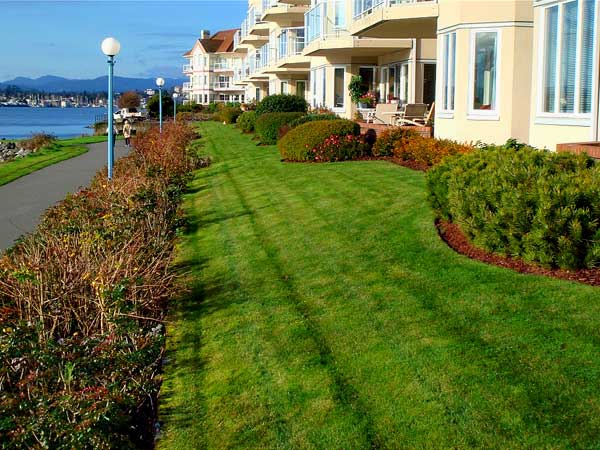
Ecological Grounds Maintenance
Too many landscape installations are hooked on chemicals and are shaped by outdated maintenance practices, which are as old-fashioned as the Ford Model T. Today’s economic and environmental realities demand a complete re-thinking and a fresh approach to the conventional grounds maintenance process.
A study of Ecological Grounds Maintenance for Multiple Housing, published by CMHC in 1995 exposes many weaknesses of the present systems and highlights the opportunities for change. Proven successes in this area of new maintenance practices have been registered by an increasing number of municipal parks departments which have converted to the Plant Health Care Program (PHCP) or to similar environmentally-friendly maintenance programs. Ecological maintenance has been common practice in western European countries for a decade where it has been fully accepted as the only way to go. There is, however, little such evidence of such evolution and innovative change in the local property management of commercial or housing landscapes.
What is wrong with so many landscaped sites?
A property manager must demand from a grounds maintenance program a number of prerequisites to balance the budget and ensure the well-being of the built landscape. These are the main criteria for any landscape maintenance program:
- Protection of the investment;
- Receiving the true value for the maintenance dollar;
- Improvement of the grounds appearance;
- Application of preventative maintenance methods;
- Control over the property’s upkeep;
- Sustenance of the integrity of the original site layout and design.
The property owners, who may not be experts in these matters, depend on the property manager, his consultants and maintenance contractors for professional advice and professional execution of all maintenance tasks. Unfortunately, the client does not always get what is in their best interest, to the detriment of the sites and the environment as a whole. Here are the most obvious and persistent problems that are evident in many maintained landscapes:
- Wholesale application of herbicides and chemical fertilizers damage the plant sustaining soil, add to compaction and render the soil sterile due to the elimination of necessary microorganisms;
- Removal of natural ground cover and leaves from underneath shrubs rob the soil of necessary protection, causing it to dry out. A recent site assessment conducted by the author of a 10-year-old project revealed that 70 per cent of the originally planted trees and shrubs had died and had been removed. The remaining plants showed significant stress and were in a declining state of health. Furthermore, soil tests showed a complete lack of humus and nutrients, and the soil was leached out and dry, despite the existence of an irrigation system;
- Edging of planting beds and tree saucers tend to increase the area of exposed soil. One question to ask is what purpose does a 2m diameter tree saucer serve for established trees. This practice leads only to unsightliness and to extra maintenance tasks;
- Lawns are usually perfectly green and weed-free, mimicking the appearance of a golf green. All of this effort and cost would be better spent instead on improving the soil. The question arises: do we show allegiance to the client/owner or to the chemical industry;
- The excessive “trimming” of flowering shrubs into neat round balls is a continuing disease afflicting almost all landscaped sites. This mutilation has become a standard practice, rendering useless otherwise decorative, flowering shrubs. Apparent to anyone with knowledge on plants, their requirements and to those who apply good horticultural practices, these shrubs need only selective or rejuvenating pruning which may be administered on an as-needed basis.
The above is only a partial list of don’ts. All of these practices are labour and energy intensive. Instead, more attention should be paid to improving the soil condition, mulching, use of compost, organic fertilizers, and above all, application of good horticultural practices. The common understanding of “curb appeal” may not be the only criterion for landscape maintenance anymore, as it may not represent the ideal picture of required, appropriate maintenance tasks.
A new and ecological approach to the management of the built landscape offers many benefits and opportunities. Primarily, this change would benefit the health and longevity of the landscape installation (i.e. the protection of the original investment)! Such a change would bring with it a new outlook on how to do things better. It would require a revision of out-dated or perceived quality standards. The new standards will require from the gardener a good understanding of the long-term implications of all maintenance tasks and ecologically-sensible procedures. This new approach will open up new work areas such as soil improvement, on-site composting, mulching, site performance monitoring and reporting, individual needs assessments, and will provide the opportunity to develop new maintenance management strategies. The onus must be put squarely on the shoulders of the landscape industry. The industry must convince owners and property management that these changes are for the betterment of the landscape and that they are in the interest of the owners, the public and the environment.
Instead of being mandated by public opinion or forced by legislation to change these conventional methods, the industry should consider these changes now and evaluate both the possibilities and the opportunities for such alternative methods. Ecological and plant health care programs can not and should not be implemented overnight but should be introduced step by step to ensure satisfactory results. A thorough and conscientious assessment of present methods and specifications would be the first step towards a new landscape maintenance management process.
MARIUS OIS
Marius Ois is the principal of Marius Ois & Associates Inc. Landscape Architects and Site Planner, and lectures at Ryerson Polytechnic University
Adapted from an article published in LANDSCAPE TRADES (April 1996)
